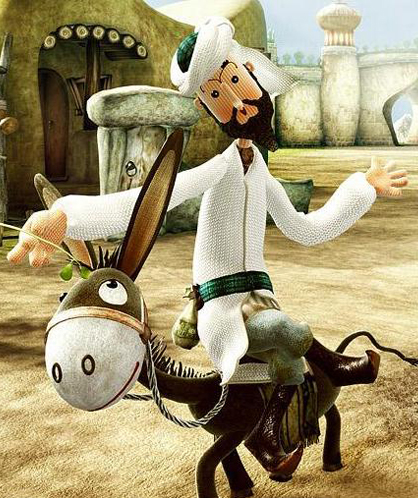 |
|
A still of A Fan Ti ("The Story of Effendi") puppet film by Shanghai Animation Film Studio in 1980s. Puppets created by the Shanghai Animation Film Studio more than 20 years ago are works of art requiring great skill. [File Photo] |
Back in 1995, a quirky movie involving a cowboy and a spaceman turned the animated film industry on its ear. The hugely successful "Toy Story" was the first full-length, completely computer-generated animated movie and the popularity of the technique skyrocketed.
Today, it is widely used in all kinds of feature films and dominates the mainstream animation world where movies such as "Finding Nemo," "Cars," "A Bug's Life" and "The Incredibles" have become massive hits.
Consequently, it is against the trend to make a traditional stop-motion animated films these days, especially puppet films, which arguably involve the most complicated craftsmanship, the highest requirement for facilities and the longest production period.
The Shanghai Animation Film Studio, which has produced numerous classic animations, basically ceased production of puppet films after 2004.
The puppet film crew, which once exceeded 100 at its peak, was down to about 10.
One of the two remaining puppet animation masters working is chief puppet film director Hu Zhaohong. In an exclusive interview with Shanghai Daily, Hu talked about the ups and downs of the genre in China, the development of the craft, the future and his new project, a puppet film adapted from French science-fiction writer Jules Verne's classic "Twenty Thousand Leagues Under the Sea."
The 57-year-old director is three years from retirement and he is very worried about the future of the puppet film genre fearing the craft will be lost like so many other traditional Chinese crafts.
Filming "Twenty Thousands Leagues Under the Sea" is his first step towards reviving the genre.
"Our puppet film techniques are no worse than any country in the world, not even America which has produced great puppet films like 'Corpse Bride'," says Hu.
"And I'm positive about the market because it is closer to our aesthetics since you use real-world objects in this genre, compared to non-existent computer-generated figures. Otherwise, Barbie dolls wouldn't have been popular for so many years around the world."
According to Hu, Chinese puppet films date back to the 1950s and the first Chinese animated films were puppet films. Mostly they were short films in line with the propaganda themes of the time.
The first generation of puppet animators such as director Jin Xi went to Czechoslovakia in the 1950s to learn from Cannes Film Festival winner Jiri Trnka, a Czech puppet master known as "the Walt Disney of the East."
The genre peaked in 1970s and 1980s when the Shanghai Animation Film Studio supplied numerous series including "Stories of Afunti" (Afunti is a wise man from Xinjiang Uygur Autonomous Region), and "Saving Mother" to television stations. In those days, the studio was known as the motherland of Chinese animation.
"State-owned film studios all experienced a difficult time when they were pushed into the market instead of receiving annual funding from the government in early 1990s," says Hu.
"The complicated craft and high requirement for facilities of puppet animations also made it difficult to accommodate the trend in the film world - mass production with shorter production periods."
Hu says that CGI fits that profile perfectly as the chief director is able to pass on different sections of the film to different groups of people to work on simultaneously.
On the other hand, preparation of puppet animations takes at least one third to half of the whole production period.
From 1994 to 2004, Hu's crew finished five Verne adaptations which were backed by a German producer and a 52-episode series, which wasn't too bad for a crew of 20 with only one director. But insufficient investment and lack of a proper environment forced the studio crew to take a break at the end of 2004.
"We have to think about the future, especially a future involving competition from CGI and cut-out animations. Audiences don't care whether the craft is complicated or getting lost, they only want to watch good films," says Hu.
"We should have started exploring the possibility of lowering costs and shortening production periods 10 years ago. But it was a difficult time for the studio. At least we have started now."
According to Hu, it is actually cheaper to make a puppet film compared to a CGI film today because puppet artists get paid much less than CGI engineers.
While the studio crew was forced to stop work, Hu didn't. He began recruiting young talent from local animation majors "to pick up trendy elements from the young generation and to teach them the old skills so they get carried on."
To his surprise, many students were interested, even with the meager salary the studio was able to pay them.
"The young generation is more interested in computer generated animations because that was what they grew up with," says Hu.
"But they can be trained and many of them are actually passionate about reviving the genre. "
Now, Hu has more than 10 young interns, all of whom have been trained in different areas of puppet film production. However he admits they are still a long way from mastering the technique. "It requires a lot of experience and there is no standard of what is a good puppet. It all depends on what the film needs," says Hu.
"And that is what attracts me the most. With puppet animations, you find yourself confronting new challenges with each project.
"For example, we are experimenting with how to make the facial muscles of puppets movable for film so they can show emotions, instead of just rolling their eyeballs or moving their mouths like before," says Hu.
(Shanghai Daily October 4, 2008)